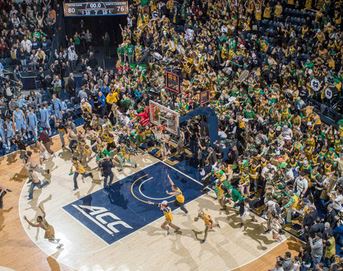Podcast: Play in new window | Download
Subscribe: RSS
When your college basketball team defeats a big rival – at home – for the first time in years, the home team fans may feel the need to release a lot of pent-up emotion right after the game ends.
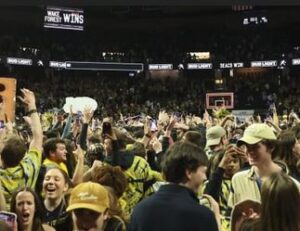
Rushing onto the basketball court immediately after the final buzzer apparently helps some fans feel like they were a part of the team’s victory, too.
In annual rivalry games, the home team’s fans have likely shown up earlier than normal prior to tip-off. The crowd will spend the next two hours during the game creating a noisy environment in an attempt to rattle the opposing team. The game itself may become a very tense back and forth affair.
When the final buzzer goes off with a home team victory, some fans may be even more excited about the surprising victory than their own basketball players are. Hundreds and even thousands of these arena “benchwarmers” are ready to come down to celebrate with their comrades on the basketball court.
And that’s when the trouble often begins.
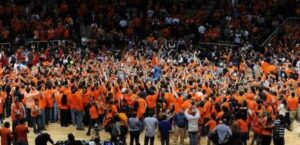
The opposing team’s players and coaches are dejected after losing a close game. Before they have a chance to exit the court, they now see hundreds of exuberant fans rushing onto the hardwood to celebrate with the victorious home team. On some occasions, the post-game celebration gets a little too rowdy.
Wake Forest fans went wild on Saturday
The Duke Blue Devils traveled down I-40 West to Winston-Salem on Saturday to play an important ACC game against conference rival Wake Forest.
The game was a hot ticket. This was the first home sell-out basketball game for the 18-9 Demon Deacons since the year 2017. The students were primed and ready for this game. A win over the #10 Duke Blue Devils (21-6) would serve to increase the chances for Wake Forest to receive an invitation to the NCAA March Madness basketball tournament field in a few weeks.
Though Duke trailed by four points with just two seconds left in the game, Blue Devils’ coach Jon Scheyer (a former Duke player) was concentrating on a way to create a final shot opportunity to win the game. He was too focused to think about a sea of Wake Forest fans getting ready to swarm onto the floor in a post-game celebration.
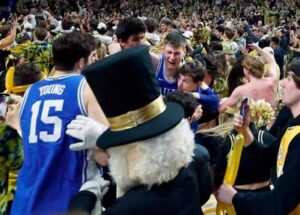
“You’re still trying to hope that somehow you can get fouled at the end,” Scheyer said. “I’m never going to give up in a game. You want to do everything you can do to give yourself the chance.”
Duke’s final attempt failed. Hundreds of Wake Forest basketball fans immediately descended onto the floor to whoop it up with their basketball team.
Unfortunately, Duke’s starting center Kyle Filipowski sustained a minor injury to his right knee moments after the game ended. A wild-and-crazy Wake Forest fan bumped into him as Duke’s big man was trying to wade through the crowd to get into the visitor’s locker room.
Duke coach Jon Scheyer later admitted that he should have pulled his starters off the floor before the game ended. He could have sent them into the locker room before the final buzzer to have avoided possible injuries to key players.
“That’s a mistake on my part,” said Scheyer.

Tigers win! Tigers win!
Just two days earlier, the LSU Tigers men’s basketball team rallied in the second half to defeat SEC rival Kentucky in Baton Rouge 75-74 on a frantic last second shot.
Like Wake Forest, the 14-13 Tigers were playing in front of their largest home crowd of the season, too. Beating Kentucky (now 21-9) in college basketball is LSU’s winter equivalent of taking down Alabama during fall football season in Baton Rouge.
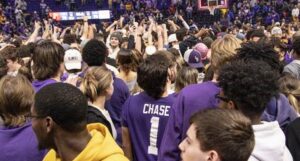
As the game ended, LSU fans rushed onto the court right after the winning shot fell into the basket. Fortunately, none of the Kentucky basketball players appeared to have been injured as they found their way back to the locker room.
The SEC’s rules were updated in 2023 for this type of post-game celebration issue.
As a result of fans storming the court a few days ago, LSU will pay a fine of $100,000 to the conference for their spontaneous outburst. By the way, the fine will increase to $250,000 for a second offense and jumps to $500,000 for a third time within a season.
Did you know that the SEC will redistribute the money to the visiting school (in this case, Kentucky)?
Most major conferences have provisions to fine its member institutions if home team fans rush onto the basketball court before the other team makes it into the locker room area. However, the fines are not as punitive as the SEC. For example, the Pac-12 Conference will assess a fine of just $10,000 for the first offense of the season.
Schools participating in the smaller conferences generally address this type of issue on a case-by-case basis. The league commissioner will make a determination regarding the most appropriate punishment (if any). Most schools will receive a warning on the first offense.
Fines might sound good, but they generally don’t stop the problem
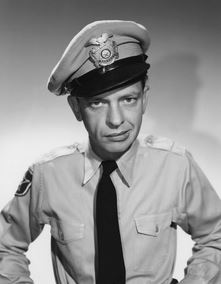
Many times, a court storming event happens right after the home team hits a game winning shot in the final moments. That’s what occurred in Thursday night’s win by LSU over Kentucky. A spontaneous burst of emotion cascaded through the crowd. Immediately, a sea of humanity came running onto the basketball court at the Pete Maravich Assembly Center to celebrate the big victory with the Tigers’ players and coaches.
Even if the home court public address announcer reminds the crowd of the consequences during close ball games, the emotions of the moment generally triumph over logic. The universities walk a fine line between encouraging enthusiasm for its sports teams and having problems occur caused by those exuberant fans.
Former Virginia Tech basketball coach Seth Greenberg said that court storming is a mixed bag for the university.
“Let’s face it, most of those schools, when you have that moment, you’re willing to pay the fine,” said the former coach-turned-ESPN analyst. He added, “That’s a great marketing tool for your university in terms of showing really the synergy between the student body, athletic department and the institution.”
The top-rated basketball schools see it happen a lot
This season, the Purdue University men’s basketball team has been ranked as one of the top five teams for most of the season. They are #2 this week in the AP Poll with a sterling 25-3 record.
Their top player knows firsthand about post-game court storming during his four years in college.
Purdue’s Zach Edey is 7’4” and was the national “Player of the Year” in 2023. He recalled that the Boilermakers have seen the basketball court stormed by fans on ten of the team’s 11 road losses over the past three years.

Zach Edey believes that alcohol (which is now being served at many college basketball arenas) is helping to fuel the increase in court storming in recent years.
“Students, probably a lot of drunk students, charging the court against another team isn’t the safe thing to do, but I think it’s a part of the game,” said Edey.
So, what can or should be done?
Let’s take a look at a few options – beginning with the most punitive.
Forfeit the game – The threat of the home team losing the game by forfeit would definitely bring a swift end to the court storming problem. However, most college athletics directors are quite aware that creating a fun environment during home games makes for good business, too. I could see this measure implemented by some conferences as a type of “third strike”, though.
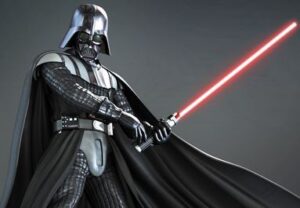
No fans allowed into the arena for the next home game – I read about this idea over the weekend. The team would be allowed to keep the win. However, the home team’s revenues for the next home game would virtually disappear. If the team played in a 12,000 seat arena with an average price of $25, the loss of up to $300,000 in ticket revenue would catch your attention. Another $100,000 in lost concessions revenue would add to the pain. The television broadcasters would put pressure on conferences to avoid this idea. Nothing is worse for television than playing a basketball game in an empty gymnasium.
How about a compromise idea?

No fans allowed on the floor until 60 seconds are run off the shot clock following the game – If a full minute was provided for the opposing team and referees to clear the floor, the safety concerns would significantly decrease. Most home team fans simply want to whoop it up and take a few selfies while standing on the school’s basketball court.
The PA announcer should address several times (before the game, during halftime, and late in the game) that no one is allowed onto the basketball floor until 60 seconds after the final buzzer for safety reasons. The home team’s pep band (or a recorded version) can strike up the alma mater to freeze the home school’s fans in place. Once the timer has passed one minute, it is then permissible for fans to safely come onto the basketball floor.
If basketball fans fail to observe the 60-second rule after the game ends, a forfeit by the home team should become the punishment.

College basketball fans are smart. They would quickly understand this concept and adapt.

